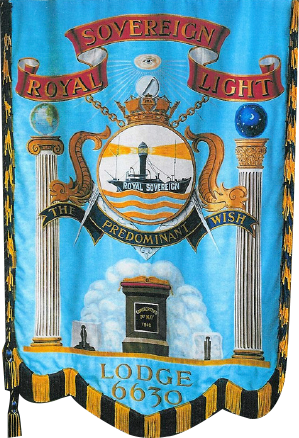Royal Sovereign
The Royal Sovereign Light Ship, Light Vessel and Tower Position: 50° 43’.40 N 00° 26’.13 E
What’s in a name?
The first mention of the Royal Sovereign was in 1634 when King Charles 1st, told his Master Shipwright, Phineas Pett, of his resolution to build, “a great new ship”. Within weeks Trinity House had raised objections to what they called, “the strange and large dimensions” of the proposed new vessel, which was to be 124 feet long in the keel, 46 feet in breadth and have a draught of 22 feet. Despite all the objections, Charles 1st proceeded, being entirely convinced that Britain could only recover her lost prestige by having the greatest maritime strength in the world. This vessel was launched on October 13th 1636 and had a long and successful career as a flagship of the Navy, including leading the attack against the French Navy in July 1690 in the Battle of Beachy Head. It was in this battle that she narrowly missed running aground on some inshore reefs known locally as ‘the shoals’. This led to her name change from Sovereign of the Seas to Royal Sovereign. She was finally destroyed by accidental fire in Chatham in 1696 in her 60th year.
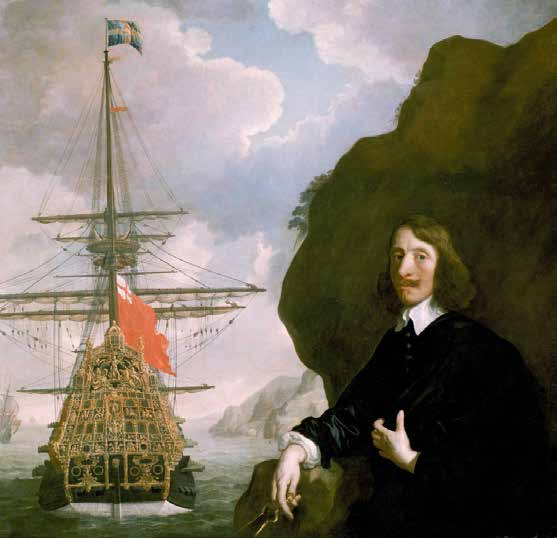
Peter Pett & the first Royal Sovereign
A second Royal Sovereign
The second Royal Sovereign was the first of the 18th century First Rate Ships built by Fisher Harding. She showed an increase in size over the earlier vessel having three decks, a keel length of 174 feet, a beam of 50 feet and carried 50 guns- only HMS Victory exceeded these dimensions. This was the vessel that saw action at the Battle of Trafalgar on October 21st 1805. She was the command of Vice Admiral Lord Cuthbert Collingwood who led the leeward line of ships. Royal Sovereign was the first vessel to open fire in the battle and hit the Santa Anna causing severe damage. So when our founders chose the name ‘Royal Sovereign Light’ to distinguish the new lodge in Bexhill they agreed a name once borne by great and proud ships of the line that hold a very special place in British Naval History.
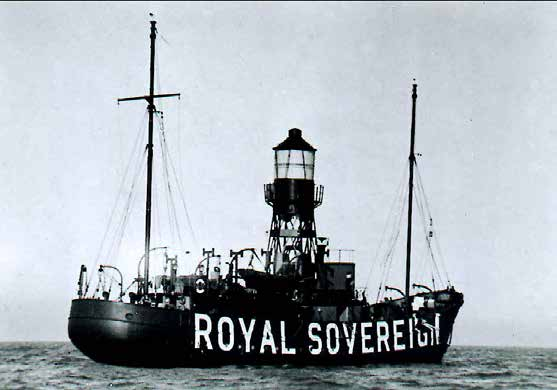
The Predominant Wish
It was in 1875 that a light vessel was first established on the Royal Sovereign shoals,7 miles from Bexhill 11 miles from Eastbourne. This vessel was also the first to have a flashing light. It showed 3 successive flashes at one minute intervals. The character was subsequently changed to 3 quick flashes every 45 seconds in 1877. The light vessel was of a composite build using timber and steel.
In the twentieth century it was decided by Trinity House to replace a number of light vessels. This saw the Royal Sovereign Light vessel replaced by the Royal Sovereign Tower. The vessel was subsequently sold to be used as a restaurant in Haslar Marina, Gosport. The vessel was painted a stunning lime green and renamed ‘Mary Mouse 2’.
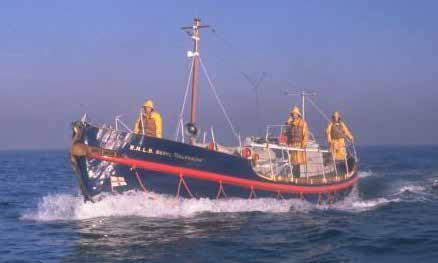
Christmas delivery to the lightship by the RNLB Beryl Tollemache
“Let there be Light”
When the Royal Sovereign Light Tower was completed in 1971 its final cost was £1.6 million. Its very special shape must have caught the eye of many thousands of residents and visitors when they enjoyed a stroll on the surrounding sea fronts. But perhaps the best remembered feature will be the light that it emitted in fair weather and foul, warning working mariners of the dangerous Royal Sovereign Shoals.
The original lamp was a 1000 watt, 100 volt lamp giving one flash every 20 seconds with an intensity of 2,500,000 candelas. This gave a range of 28 sea miles and was positioned 112 feet above High Water, whilst the fog signal gave uniform sound radiation and had a range of 5 miles.
Prior to automation in Autumn 1994 the lamp had been changed to a 400 watts Electric Metal Arc giving the same signal and intensity.
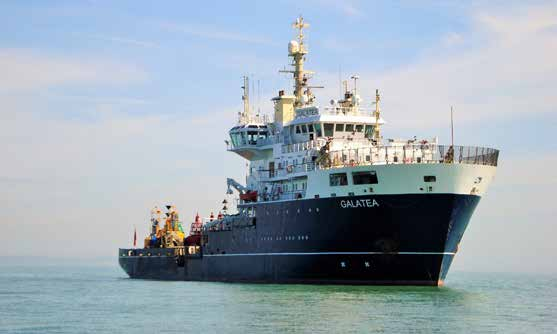
Crew of the Royal Sovereign
The keepers of the Tower worked a month on and a month off. Personal supplies of food and clothing were taken each time the crew changed.
Facilities improved as technology improved. Initially, on the lightship, fresh meat was salted but of course fridge’s and freezers were installed in the Light Tower.
Over the years the crew of the Eastbourne Lifeboat delivered extra Christmas ‘goodies’, courtesy of friends and supporters. In more recent years the transfer of these was by helicopter. In 1989 W.Bro. Roy Sydney was allowed to accompany the goods sent following the traditional collection at the November lodge meeting. This led to the start of a friendship with the then keeper, Dave McGovern. Dave was the last keeper of the Tower and transferred to other stations when automation took place.
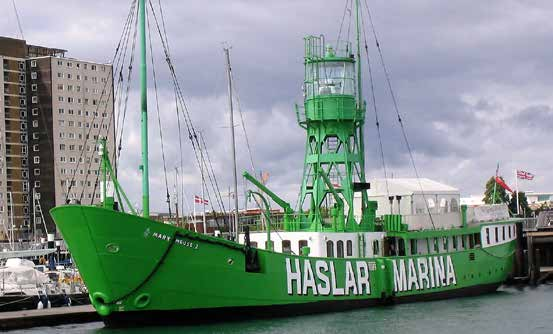
Mary Mouse 2
Into the 21st Century
Automation of the Royal Sovereign Light Tower was completed in the Autumn of 1994 when it was converted to solar power. Banks of solar panels are mounted in steel frames at an angle of 65 degrees facing south adjacent to the lantern tower. The optic was replaced by a synchronised set of lanterns with six lamps. Each lamp is little bigger than a human index finger and these are arranged on a plastic mount best described as a ‘snowflake’ shape. When a bulb fails the automatic lamp- changer moves the next new bulb into position until bulb number 5 is reached.
At this stage an electronic trip message is sent by Vodaphone link to Harwich from where the Royal Sovereign Light Tower is monitored, this enables plans to be put in hand for the lamp-changer to be replaced.
This work is carried out by either of the two Trinity House ‘Galatea’ or ‘Alert’.
Since automation the main light was reduced in range from 28 sea miles to12 sea miles and the former air horn fog signal was replaced by a SA850 electric fog signal with a fog detector.
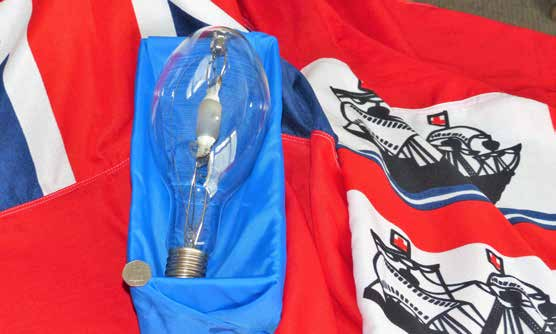
Bulb and ensign from the Tower 1994
Extracts from Trinity House
This lighthouse was completed in 1971 and replaced a light vessel which had marked the Royal Sovereign Shoal since 1875. It is of concrete construction and was built in two sections on the beach at Newhaven. The base and vertical pillar section were floated into position and sunk on to a levelled area of the sea bed and the upper cabin section and superstructure were then floated over the pillar section. The pillar had an inner telescopic section which, when attached to the cabin, was jacked up 13 metres and locked into position. The underside of the cabin is well above the maximum wave height and the navigation light is 28 metres above sea level.
The cabin section contained accommodation for the keepers who manned the lighthouse before its automation in 1994. The flat upper deck of the cabin section provides a helicopter landing platform. The lighthouse tower, with the control room, fog signal room and lantern is located at one corner of the main deck with direct access to the cabin section below. Automation of the Royal Sovereign Lighthouse was completed in August 1994. The optic was replaced by a biform synchronised set of lanterns made by Tideland Signals Ltd each containing a lamp-changer with 6 lamps.
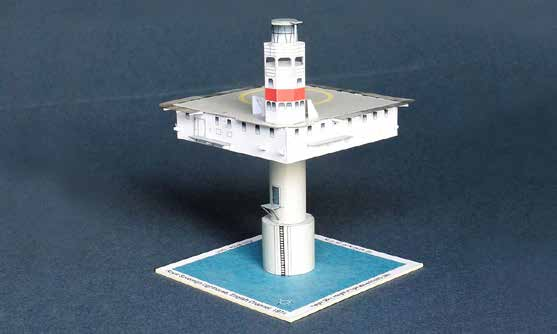
A model of the Royal Sovereign Light Tower 1971
